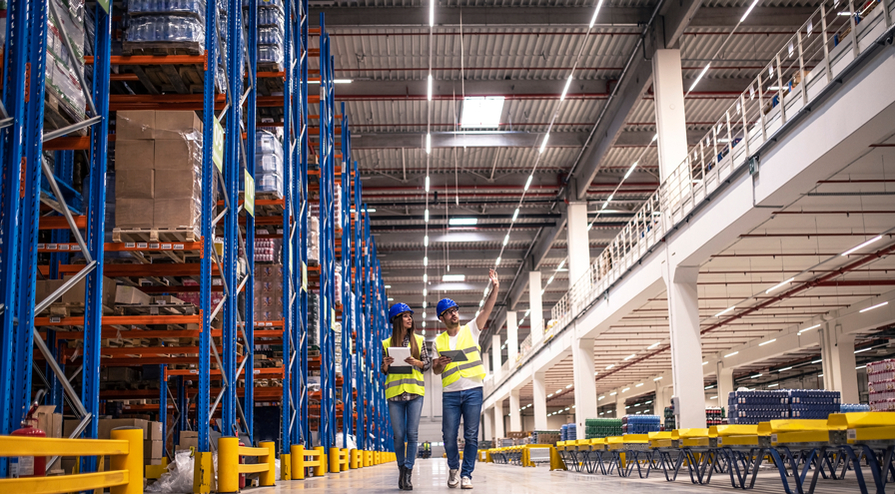Warehouse space is in short supply. The global pandemic spurred an eCommerce boom and a shift in inventory strategies that skyrocketed demand for coveted logistics real estate. The average U.S. warehouse vacancy rate has plummeted to 5.5% and many Canadian cities are experiencing the lowest vacancy rates in North America.
In a desperate scramble for space, businesses have had to get creative. A closed Sam’s Club store in Memphis, Tennessee, for example, has been converted into an eCommerce fulfillment center. In some instances, dead malls are now home to logistics hubs. One food manufacturer has been forced to store roughly a third of its orders in a parking lot.
This heightened demand means that it’s a landlord’s market. As a result, we’re seeing inflated rent costs (with industrial rents increasing 7.4% YOY) and more long-term leases on the market. Many developers have started building and preleasing speculative spaces knowing once they’re completed (or even before they’re completed) tenants will be lining up.
In such an overly competitive real estate landscape, many businesses are finding themselves unable to secure warehouse space or restricted to rigid situations that don’t fit their needs. Amid these challenges, many businesses could find benefits in flexible and multi-client space. These solutions can help businesses support peak season surges, scale under one roof, and/or glean cost efficiencies for smaller operations.
How the Pandemic Altered Logistics Real Estate in the Long Term
ECommerce volume has been steadily climbing for years, but the pandemic caused it to skyrocket. Globally, eCommerce experienced five years’ worth of growth in 2020 alone.
With this shift to eCommerce, much of the work and storage is being moved out of brick-and-mortar locations and into warehouses. Combine this with the fact that eCommerce operations are more space intensive, and we begin to see how the boom in eCommerce is gobbling up extensive storage space.
Additionally, many companies are shifting from “just-in-time” to “just-in-case” inventory strategies, learning lessons from the shortages of the pandemic. While just-in-case inventory (also known as safety stock) adds resilience and reduces risk in the supply chain, ProLogis estimates that this shift alone could create up to 114 million square feet of additional logistics demand per year over the next five years.
Safety stock and booming eCommerce growth are putting a tremendous strain on available warehouse spaces. According to commercial real estate firm JLL, the U.S. could need an additional 1 billion square feet of warehouse space by 2025.
Multi-Client Solutions Offer Flexible Space Amid Scarcity
These circumstances make it clear that capacity issues might be here for the long run. Luckily, flexible space and multi-client solutions offer problem-solving for both short-term and long-term needs.
Flexible space can be flexible in terms of both timeframe and square footage, and there are several ways companies can benefit from such solutions. Some businesses need short-term space to support peak season. Businesses experiencing rapid growth might want a flexible space deal so that they can scale under the same roof without having to go into overflow storage. But because of the ultra-competitive warehousing real estate market, short-term and flexible space can be difficult to pitch to landlords.
Growing businesses can also benefit from the flexibility of shared warehouse space. For example, if an eCommerce operation only needs 25,000 square feet of space, it wouldn’t be cost effective for them to lease a 25,000 square foot building alone and be burdened with 100% of the real estate costs. Instead, it would be much more economical for that company to find a larger warehouse with 25,000 square feet available and then split the building expenses with other tenants.
Enter: multi-client solutions. At Kenco, we are investing in multi-client warehouses across North America to provide flexible space for customers who need it. By securing larger warehouses than needed, we’re able to accommodate several tenants at once, including smaller businesses, rapidly growing businesses, and businesses with distinct peak seasons. The warehouses are outfitted with innovative warehouse and inventory management systems and offer clients customizable warehouse space and supply chain management.
In the spirit of finding innovative ways to combat capacity shortages, Kenco is also rolling out AutoStore’s Robotics Shuttle system, an automated storage and retrieval system that packs goods at a high density and uses robots to retrieve them. The system saves space not only with high-density storage, but its automation eliminates the need for the majority of handling equipment, freeing up even more space and cutting costs. In our distribution center where AutoStore’s system is deployed, we expect to see $9 million in savings over a five-year period.
Key Takeaways
The logistics real estate market is forever altered. ECommerce growth and just-in-case inventories are trends that will continue to impact storage space demand long after the pandemic has subsided. To navigate these challenges, businesses can partner with a trusted 3PL that is investing in flexible, multi-client solutions and innovative technologies to keep your supply chain resilient.

